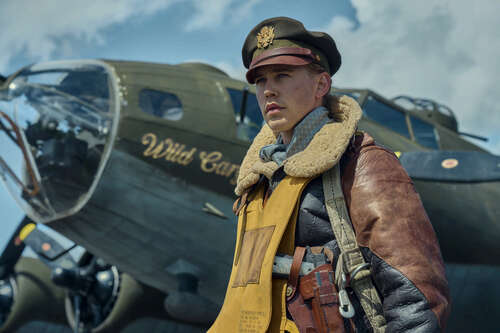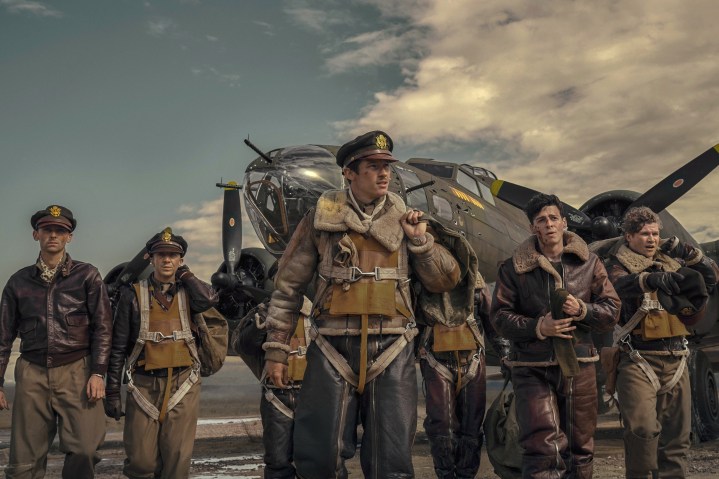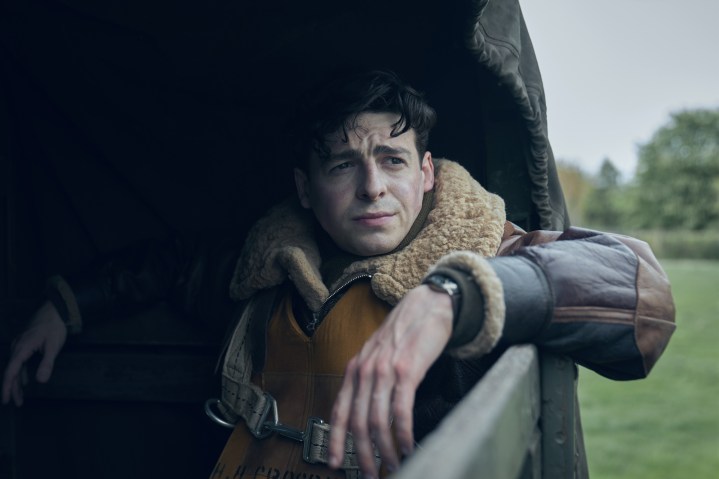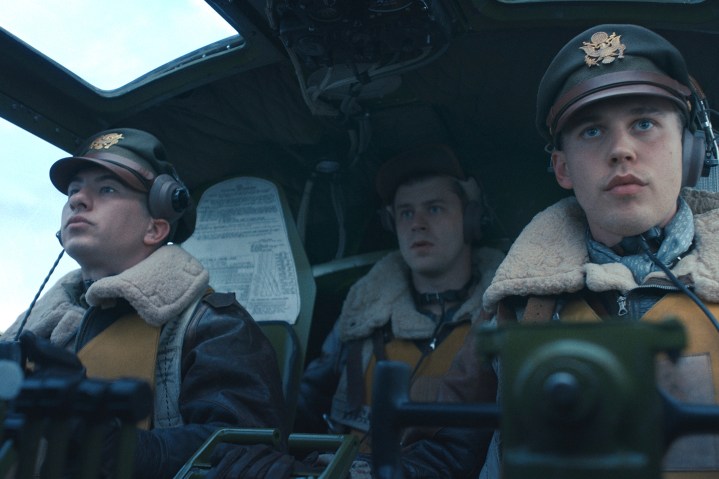
“Apple TV+’s Masters of the Air is an emotionally engaging, visually stunning, and frequently thrilling epic.”
Pros
- An ensemble of charismatic, likable performers
- Stunning visuals throughout
- Blake Neely’s emotionally stirring score
Cons
- A number of underdeveloped characters
- Uneven pacing throughout its middle episodes
There’s something uniquely enduring about well-made World War II thrillers. Maybe it’s because going to Europe to fight the Nazis remains one of the most morally uncomplicated causes of war in American history. Maybe it’s because there’s still a general respect for the men who fought the war that hasn’t been totally extinguished. Whatever the reason, Masters of the Air doesn’t feel outdated, old-fashioned, or stale, and that is a miracle in and of itself.
The third installment in a trilogy of Steven Spielberg and Tom Hanks-producedm WWII-set miniseries, Masters of the Air offers a different perspective on the infamous war than its two predecessors. Unlike Band of Brothers and The Pacific, both of which tell decidedly on-the-ground stories, the new Apple TV+ show focuses on the efforts of the 100th Bomb Group, a United States Air Force outfit of B-17 pilots and crewmen that was tasked with helping the Allies take control of Europe by dropping bombs on Nazi-controlled regions of the continent.
Despite the differences that separate it from its fellow WWII dramas, Masters of the Air succeeds for many of the same reasons as Band of Brothers and The Pacific. Not only is it exceptionally well-made, but it also boasts a level of heart that allows its broad, uncomplicated notions of heroism to hit far, far harder than they should. It’s a nine-hour Dad Epic of the highest order — one that is ironically overflowing with some of Hollywood’s most promising young performers.

Based on Donald L. Miller’s 2007 nonfiction book of the same name, Masters of the Air follows and dramatizes the adventures of several members of the 100th Bomb Group — a unit that was unofficially nicknamed the “Bloody Hundredth” due to all the losses that it experienced throughout World War II. The series’ ostensible leads are best friends Gale Cleven (Austin Butler) and John Egan (Callum Turner), a pair of majors in the U.S. Air Force. They are joined in the 100th by Harry Crosby (Anthony Boyle), a talented navigator prone to airsickness; Curtis Biddick (Barry Keoghan), a brash, cocky bomber pilot; and Robert “Rosie” Rosenthal (a breakout Nate Mann), a natural-born leader.
As is the case in Band of Brothers and The Pacific, certain faces come and go throughout Masters of the Air’s nine episodes. Some characters are sent home, while others meet tragic ends in their planes. Contrary to what the revolving door nature of its cast might suggest, though, Masters of the Air acknowledges the bloody cost of war without going out of its way to bludgeon viewers with tragedy and death. Created by John Shiban and John Orloff, it’s a series that is most interested in exploring the bravery of its real-life heroes, all of whom demonstrated astonishing levels of both courage and camaraderie in the face of unimaginable horror. Its intended effect is bittersweet, but uplifting, and throughout its installments, Masters of the Air gradually earns its climactic swells of emotion, catharsis, and heartbreak.
That’s due, in no small part, to the efforts of its performers, most of whom bring distinct layers to their characters even when Masters of the Air’s scripts don’t have enough time for them. Turner shines as the emotional, reckless Eagan, while Butler cements his place as one of Hollywood’s few genuinely up-and-coming movie stars with his clear-eyed, personality-driven performance as Gale Cleven, the unofficial leader of the 100th’s pilots. Opposite them, Keoghan and Boyle predictably steal more than a few scenes playing two characters who could not be more different from each other. Newcomer Mann, meanwhile, turns in a memorable performance as Rosie, a pilot whose commitment to his unit drives him to impressively heroic heights.

The series does its best to give each of its characters their due, but it inevitably struggles to successfully juggle all of its various pilots and crewmen. Certain figures, like Bel Powley’s Alexandra Wingate and Laurie Davidson’s Herbert Nash, aren’t developed as deeply as they could be. The show’s late-season attempt to broaden the scope of its story by introducing the perspectives of the Tuskegee Airmen, a group of African American fighter pilots, is undeniably admirable as well, but the unit’s introduction comes too late for its members to be given as much depth as many of their white counterparts.
These issues are, thankfully, alleviated by several ingenious choices made by Shiban, Orloff, and their fellow writers. Their decision to center each of Masters of the Air’s first four episodes, in particular, around individual missions lends a heightened narrative focus and sturdy episodic structure to its initial installments. By introducing several non-air-based storylines in its second half, the series is also able to grow into an even more comprehensive portrait of its real-life soldiers’ wartime experiences than many may expect.
Masters of the Air is additionally elevated at all times by the sheer craftsmanship on display throughout it. Director Cary Joji Fukunaga and cinematographer Adam Arkapaw establish a visual vibrancy in the show’s opening chapters that is maintained by its other directors, Dee Rees, Tim Van Patten, and Anna Boden and Ryan Fleck. With its eye-popping colors, impeccable production design, muscular direction, and impressive visual effects, the miniseries is able to achieve an even greater cinematic quality than both Band of Brothers and The Pacific, and which still feels rare on TV.

Masters of the Air isn’t ultimately as narratively balanced as its two Spielberg and Hanks-produced predecessors, but its cast and spirit of technical showmanship help it make up for its shortcomings. Only a few weeks into 2024, it’s already emerged as a contender for the title of the year’s most visually stunning, well-crafted miniseries. Never once does it seem like it’s on the verge of crashing into the ground. On the contrary, it soars more often than it doesn’t.
The first two episodes of Masters of the Air are streaming now on Apple TV+. New episodes premiere weekly on Fridays. Digital Trends was given early access to all of the series’ nine installments.
Editors’ Recommendations

